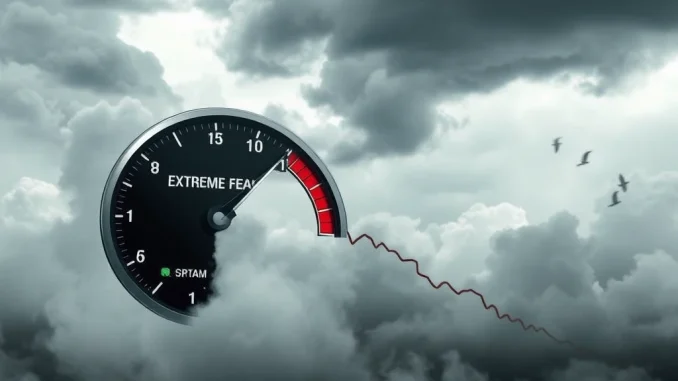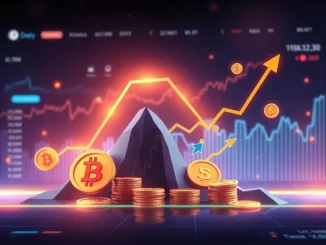
Hold onto your digital wallets, crypto enthusiasts! The market sentiment has taken a sharp turn, and the Crypto Fear & Greed Index is flashing red. In a dramatic shift, the index has plummeted 11 points, landing squarely in the dreaded ‘Extreme Fear’ zone at a chilling 23. What does this mean for your Bitcoin and altcoin holdings? Let’s dive into the details and understand what’s fueling this wave of market anxiety.
Decoding the Crypto Fear and Greed Index: Your Market Sentiment Thermometer
Think of the Crypto Fear and Greed Index as a mood ring for the cryptocurrency market. It’s a clever tool designed to gauge the overall sentiment of crypto investors. Developed by Alternative.me, this index doesn’t just rely on gut feelings; it crunches hard data from various sources to give us a numerical representation of market emotions. Ranging from 0 (Extreme Fear) to 100 (Extreme Greed), it acts as a crucial indicator for potential market movements. A low score, like the current 23, suggests investors are gripped by extreme fear, which historically can sometimes precede buying opportunities. Conversely, a high score indicates excessive greed, potentially signaling an overheated market ripe for correction.

What Factors Drive the Fear and Greed Index?
This isn’t just a random number generator! The Fear and Greed Index is built upon a robust methodology, considering six key market indicators. Let’s break down what influences its fluctuations:
- Volatility (25%): How wildly are prices swinging? High volatility often breeds fear as investors become uncertain. The index analyzes current and maximum drawdowns of Bitcoin to assess this.
- Market Momentum/Volume (25%): Are traders actively buying and selling? Large trading volumes coupled with positive momentum can suggest greed, while low volume and negative momentum might point towards fear. The index compares current market momentum and volume against the past 30-day and 90-day averages.
- Social Media (15%): What’s the buzz online? Social media sentiment, particularly on platforms like Twitter and Reddit, is analyzed to gauge the overall mood. A surge in negative crypto mentions can drag the index down.
- Surveys (15%): What are crypto investors actually feeling? While not always publicly available daily, periodic crypto surveys gauge investor sentiment directly.
- Bitcoin Dominance (10%): Where is the money flowing? Bitcoin’s dominance in the crypto market can reflect sentiment. When Bitcoin dominance rises, it can sometimes indicate a ‘flight to safety’ amid fear, while a drop might suggest investors are venturing into riskier altcoins during periods of greed.
- Google Trends (10%): What are people searching for? Analyzing Google Trends for Bitcoin-related search terms, like ‘Bitcoin crash’ or ‘Bitcoin price prediction,’ helps understand general public interest and concern.
Why the Sudden Plunge into ‘Extreme Fear’?
The drop of 11 points and the shift into ‘Extreme Fear’ didn’t happen in a vacuum. Several factors could be contributing to this increased anxiety in the crypto market analysis:
- Market Corrections: The crypto market is known for its volatility. Recent price corrections across Bitcoin and many altcoins naturally induce fear as investors see the value of their holdings decrease.
- Macroeconomic Uncertainty: Global economic factors, such as inflation concerns, rising interest rates, and geopolitical tensions, often spill over into the crypto market, increasing risk aversion.
- Regulatory Scrutiny: Increased regulatory attention and potential crackdowns in various countries can create uncertainty and fear among crypto investors.
- Negative News Cycle: Bearish news headlines, exchange hacks, or project failures can quickly dampen market sentiment and push the index lower.
Extreme Fear: Is it Time to Panic or Pounce?
Seeing the Crypto Fear and Greed Index in ‘Extreme Fear’ can be unsettling. However, seasoned crypto investors often view periods of extreme fear as potential buying opportunities. Why? Because:
- Contrarian Investing: The principle of contrarian investing suggests that the best time to buy is when everyone else is fearful and selling, and the best time to sell is when everyone is greedy and buying. Extreme fear can indicate that assets are undervalued.
- Historical Trends: Historically, periods of ‘Extreme Fear’ on the index have sometimes preceded market rebounds. It doesn’t guarantee a price surge, but it’s a pattern worth noting.
- Long-Term Perspective: If you believe in the long-term potential of Bitcoin and cryptocurrencies, short-term dips driven by fear can be opportunities to accumulate more assets at lower prices.
Important Note: The Fear & Greed Index is just one tool among many. It shouldn’t be the sole basis for your investment decisions. Always conduct thorough research, consider your risk tolerance, and diversify your portfolio.
Navigating the Fear: Actionable Insights for Crypto Investors
So, what should you do when the Bitcoin sentiment is overwhelmingly fearful? Here are some actionable insights:
- Stay Informed, But Filter the Noise: Keep up with market news, but be wary of sensationalist headlines designed to trigger emotional reactions. Focus on credible sources and fundamental analysis.
- Review Your Portfolio Strategy: Does your portfolio allocation still align with your risk tolerance and long-term goals? Market downturns are good times to re-evaluate.
- Dollar-Cost Averaging (DCA): If you believe in the long-term potential, consider employing dollar-cost averaging. This involves investing a fixed amount at regular intervals, regardless of the price, which can help mitigate the impact of volatility.
- Do Your Own Research (DYOR): Never invest blindly based on fear or hype. Understand the projects you’re investing in, their fundamentals, and their long-term prospects.
- Don’t Panic Sell: Emotional decisions often lead to losses. Avoid selling in a panic during market downturns. Consider your long-term strategy instead.
Conclusion: Weathering the Crypto Storm
The Crypto Fear and Greed Index plunging into ‘Extreme Fear’ is undoubtedly a signal of heightened anxiety in the market. While it can be unnerving, it’s crucial to remember that market cycles are inherent in the crypto world. Understanding the index, its drivers, and historical context can empower you to make informed decisions rather than succumbing to emotional reactions. Use this period to learn, strategize, and potentially position yourself for the next market upturn. Remember, in the world of crypto, periods of fear can often pave the way for future growth. Stay vigilant, stay informed, and navigate the volatility with a cool head.



